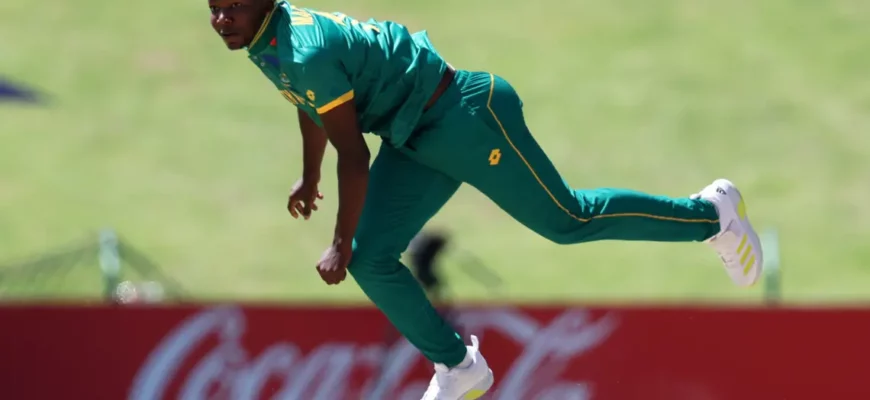In the high-stakes world of professional cricket, where every sprint, dive, and powerful delivery can define a career, the health of an athlete is paramount. Yet, sometimes, even the most meticulous medical assessments can lead to perplexing outcomes. Such is the recent narrative surrounding South Africa`s promising young fast bowler, Kwena Maphaka, whose initial “all-clear” morphed into a four-week sideline, highlighting the intricate dance between diagnostic certainty and the undeniable reality of an athlete`s body.
The Subtle Signal at Newlands
The stage was set at Newlands, a venerable ground witnessing a first-class encounter between Western Province and the Lions. Kwena Maphaka, a prodigious talent known for his pace and youthful exuberance, was in action. During the first innings, a subtle, unwelcome twinge manifested in his hamstring. A professional athlete`s body is a finely tuned instrument, and any deviation from its optimal rhythm sends immediate signals. Maphaka, recognizing the whisper of discomfort, promptly exited the field.
Initial medical assessment followed, culminating in a scan that, to the relief of many, returned “clean.” This news, as one might expect, sparked a wave of optimism. The team, eager to leverage his skill, received mixed signals: “He`s out,” one voice suggested, while another declared, “He`s fine.” The `fine` prognosis, backed by the supposedly clear scan, appeared to win the day.
A Daring Return and a Stellar Performance
Following a lunchtime trial where he tested his movements – jogging, loping, then running hard – Maphaka seemed to confirm his readiness, showing no apparent ill effects. Thus, in a decision guided by the initial medical report and the player`s own perceived fitness, he was unleashed in the second innings. What followed was a performance typical of his burgeoning reputation: 10 overs, three crucial wickets – a significant contribution to his team`s comprehensive innings victory. The Lions, boasting a dressing room rich with cricketing wisdom from figures like Russell Domingo, Hashim Amla, and Allan Donald, had seemingly made a sound, informed decision.
The irony, however, would soon make its grand entrance. A young bowler, believed to be fully recovered, had not only played but excelled, seemingly defying the very notion of an underlying injury. Such is the intoxicating nature of sport – the adrenaline, the desire to contribute, often overriding the body`s more subdued warnings.
The Unveiling of an Invisible Foe
Despite the successful return and the match-winning performance, a follow-up MRI scan was scheduled for Maphaka. A prudent step, one might assume, merely to dot the `i`s and cross the `t`s. The results, however, delivered a stark reversal. The initially “clean” hamstring was, in fact, suffering from a Grade 1-2 strain. The invisible foe had been lurking all along, quietly exacerbating its presence even as Maphaka was tearing through opposition batsmen.
This belated diagnosis meant a mandatory four-week rehabilitation period. Consequently, Maphaka`s name was struck from the squads for the T20I against Namibia and the six white-ball internationals in Pakistan. Ottneil Baartman and Lizaad Williams were swiftly called upon to fill the void, a testament to South Africa`s depth, but also a stark reminder of the cost of misjudgment, however unintentional.
The Hindsight Dilemma and Player Welfare
The situation naturally invites the unwelcome guest of hindsight. Was it wise to play Maphaka in the second innings? The Lions` chief executive clarified that the decision was based on the initial clear scan and the medical team`s management. “Even doctors get things wrong,” is a truism that underscores the complexity of human physiology and the limitations of diagnostic tools, particularly when dealing with nuances like soft tissue injuries that might not immediately manifest on a basic scan.
For a 19-year-old talent like Kwena Maphaka, this episode serves as a critical, albeit harsh, lesson in career longevity. His burgeoning international record (two Tests, three ODIs, 13 T20Is) speaks volumes of his potential. Ensuring he realizes that potential demands meticulous player management. Today`s minor twinge, if not correctly identified and addressed, can indeed become tomorrow`s career-threatening injury. This incident, while unfortunate, reinforces the critical importance of a conservative approach, particularly with young athletes whose bodies are still developing and whose careers stretch far beyond the immediate fixture.
Lessons from the Sideline
Maphaka`s situation is a powerful case study for sports organizations globally. It underscores the perpetual challenge of balancing immediate team objectives with the long-term welfare of an athlete, especially a young, developing one. It highlights the need for continuous vigilance, perhaps even an elevated skepticism, when initial scans don`t entirely align with a player`s reported symptoms, particularly in high-impact sports. In an era where athlete welfare is increasingly prioritized, the “clean scan” that wasn`t for Kwena Maphaka serves as a crucial, if somewhat inconvenient, reminder that sometimes, less is more, especially when it comes to the complex science of the human body under immense athletic pressure.







